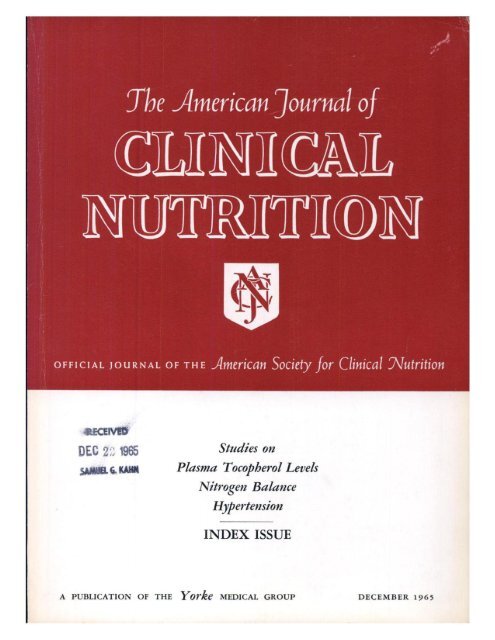绝经后女性24个月饮食和身体活动随机干预试验中的性激素变化:DAMA研究。
IF 6.9
1区 医学
Q1 NUTRITION & DIETETICS
引用次数: 0
摘要
背景:性类固醇激素在包括乳腺癌和子宫内膜癌在内的几种疾病的病因学中的作用已被广泛记载。在绝经后的女性中,雌激素和雄激素水平较高与患乳腺癌的风险较高有关。因此,研究饮食和体育活动(PA)是否以及如何调节性激素的血液浓度是很重要的。目的:我们评估24个月饮食和/或PA干预对一系列性激素血浆水平的影响。方法:234例研究对象为健康绝经后女性,年龄50-69岁,乳腺密度高,不吸烟,目前未接受激素替代治疗。他们被随机分为四个干预组:(1)以植物为主的等热量饮食干预;(2)中等强度的运动干预,每周至少进行1小时的有监督的剧烈活动;(3)饮食和运动相结合的干预;(4)对照组给予健康生活方式的一般性建议。在基线和干预结束时收集的血浆样本中,采用液相色谱串联质谱法测定雌二醇、雌酮、孕酮、17-OH孕酮、睾酮、雄烯二酮、脱氢表雄酮(DHEA)和脱氢表雄酮硫酸盐(DHEAS)的水平。用免疫分析法测定性激素结合球蛋白(SHBG),用Vermeulen法计算游离雌二醇和睾酮。采用Tobit回归模型进行统计分析。结果:24个月后,随机分配到饮食治疗组(1+3组)的女性雌二醇水平显著降低(exp(β) 0.77;95%ci 0.61, 0.97;p值0.03)和游离雌二醇(exp(β) 0.81;95%ci 0.65, 0.998;p值0.048)与对照组(2+4组)相比。其他性激素没有显著差异。PA干预无明显效果。在干预期间发生的体重变化的进一步调整并没有改变结果。结论:我们的研究结果提示,在健康的高乳腺密度绝经后女性中,以植物性食物为主的健康饮食可能对血浆雌二醇浓度起调节作用。试验注册号:ISRCTN28492718,试验注册日期:17/05/2012。本文章由计算机程序翻译,如有差异,请以英文原文为准。
Sex hormone changes in a 24-mo dietary and physical activity randomized intervention trial in postmenopausal females: the Diet, physical Activity and Mammography study (DAMA) study
Background
The role of sex steroid hormones in the etiology of several diseases, including breast and endometrial cancer, has been widely documented. In postmenopausal females, higher concentrations of estrogens and androgens are associated with a higher risk of developing breast cancer. It is therefore important to investigate whether and how diet and physical activity (PA) can modulate sex hormone blood concentrations.
Objectives
We evaluated the effect of a 24-mo dietary and/or PA intervention on plasma concentrations of a series of sex hormones.
Methods
The 234 study participants were healthy postmenopausal females aged 50–69 y, with high breast density, nonsmokers, and no hormone replacement therapy users. They were randomly assigned to the following 4 intervention arms: 1) isocaloric dietary intervention, mainly plant-based; 2) moderate-intensity exercise intervention with ≥1 h/wk of supervised strenuous activity; 3) both dietary and exercise interventions; 4) control group with general recommendations on healthy lifestyle. In plasma samples collected at baseline and at the end of the intervention, concentrations of estradiol, estrone, progesterone, 17-OH progesterone, testosterone, androstenedione, dehydroepiandrosterone, and dehydroepiandrosterone sulfate were determined by liquid chromatography tandem mass spectrometry methods. Sex hormone-binding globulin was determined by immunoassay, and free estradiol and testosterone were calculated using the Vermeulen method. Statistical analyses were performed using Tobit regression models.
Results
After 24 mo, females randomly assigned to dietary treatment (arms 1 + 3) showed significant lower concentrations of estradiol [exp(β) 0.77; 95% confidence interval (CI): 0.61, 0.97; P value 0.03] and free estradiol (exp(β) 0.81; 95% CI: 0.65, 0.998; P value 0.048) compared with the control group (arms 2 + 4). No significant differences emerged for the other sex hormones. No effect of PA intervention was evident. Further adjustment for weight change that occurred during the intervention did not modify the results.
Conclusions
Our results suggest that, in healthy postmenopausal females with high breast density, a healthy diet mainly based on plant food may play a role as a modulator of plasma estradiol concentration.
This trial was registered at the ISRCTN Registry (www.isrctn.com) as ISRCTN28492718.
求助全文
通过发布文献求助,成功后即可免费获取论文全文。
去求助
来源期刊
CiteScore
12.40
自引率
4.20%
发文量
332
审稿时长
38 days
期刊介绍:
American Journal of Clinical Nutrition is recognized as the most highly rated peer-reviewed, primary research journal in nutrition and dietetics.It focuses on publishing the latest research on various topics in nutrition, including but not limited to obesity, vitamins and minerals, nutrition and disease, and energy metabolism.
Purpose:
The purpose of AJCN is to:
Publish original research studies relevant to human and clinical nutrition.
Consider well-controlled clinical studies describing scientific mechanisms, efficacy, and safety of dietary interventions in the context of disease prevention or health benefits.
Encourage public health and epidemiologic studies relevant to human nutrition.
Promote innovative investigations of nutritional questions employing epigenetic, genomic, proteomic, and metabolomic approaches.
Include solicited editorials, book reviews, solicited or unsolicited review articles, invited controversy position papers, and letters to the Editor related to prior AJCN articles.
Peer Review Process:
All submitted material with scientific content undergoes peer review by the Editors or their designees before acceptance for publication.

 求助内容:
求助内容: 应助结果提醒方式:
应助结果提醒方式:


